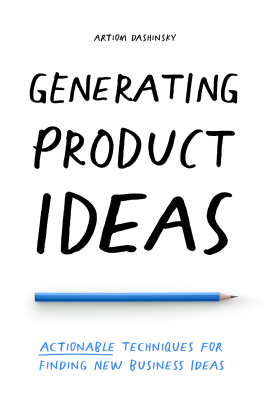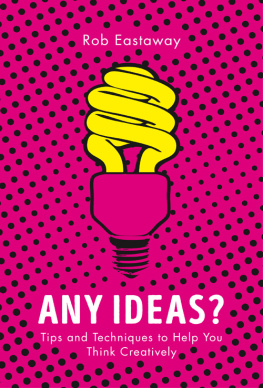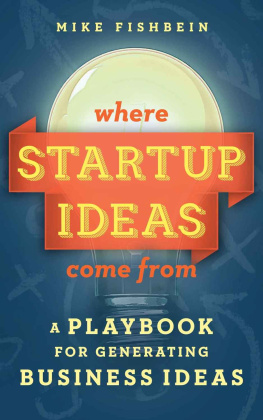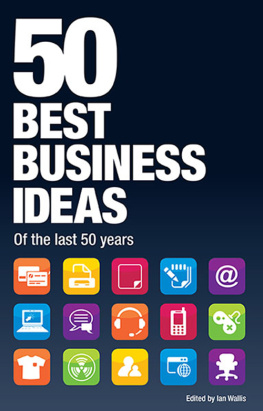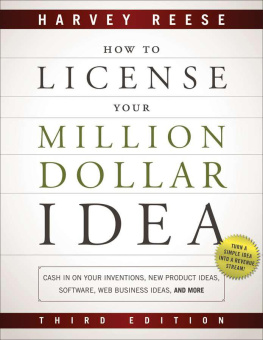Artiom Dashinsky - Generating Product Ideas — Actionable Techniques for Finding New Business Ideas
Here you can read online Artiom Dashinsky - Generating Product Ideas — Actionable Techniques for Finding New Business Ideas full text of the book (entire story) in english for free. Download pdf and epub, get meaning, cover and reviews about this ebook. year: 2020, genre: Home and family. Description of the work, (preface) as well as reviews are available. Best literature library LitArk.com created for fans of good reading and offers a wide selection of genres:
Romance novel
Science fiction
Adventure
Detective
Science
History
Home and family
Prose
Art
Politics
Computer
Non-fiction
Religion
Business
Children
Humor
Choose a favorite category and find really read worthwhile books. Enjoy immersion in the world of imagination, feel the emotions of the characters or learn something new for yourself, make an fascinating discovery.
- Book:Generating Product Ideas — Actionable Techniques for Finding New Business Ideas
- Author:
- Genre:
- Year:2020
- Rating:3 / 5
- Favourites:Add to favourites
- Your mark:
- 60
- 1
- 2
- 3
- 4
- 5
Generating Product Ideas — Actionable Techniques for Finding New Business Ideas: summary, description and annotation
We offer to read an annotation, description, summary or preface (depends on what the author of the book "Generating Product Ideas — Actionable Techniques for Finding New Business Ideas" wrote himself). If you haven't found the necessary information about the book — write in the comments, we will try to find it.
Artiom Dashinsky: author's other books
Who wrote Generating Product Ideas — Actionable Techniques for Finding New Business Ideas? Find out the surname, the name of the author of the book and a list of all author's works by series.
Generating Product Ideas — Actionable Techniques for Finding New Business Ideas — read online for free the complete book (whole text) full work
Below is the text of the book, divided by pages. System saving the place of the last page read, allows you to conveniently read the book "Generating Product Ideas — Actionable Techniques for Finding New Business Ideas" online for free, without having to search again every time where you left off. Put a bookmark, and you can go to the page where you finished reading at any time.
Font size:
Interval:
Bookmark:

The Framework
Were going to start with four techniques that focus on observation. They help us to learn actively by finding problems around us that we might have already developed some interest in, passion for, or experience with.
All of these techniques are also helpful to adopt as ongoing mindsets that will help you to notice problems and opportunities around you in the future.
#1: Solving your own business problems
#2: Productizing your own life experiences
#3: Insider ideas
#4: Vision-based ideas
#1: Solving your own business problems
Solving your own problems is arguably the best way to find ideas for startups. As Paul Graham, the founder of YCombinator says: At YC we call ideas that grow naturally out of the founders own experiences organic startup ideas. The most successful startups almost all begin this way.
With this technique, were going to create a matrix that helps to extract such ideas from your work experiences (for personal experiences check out the next technique).
These could be projects or roles; something you do in your day job, as a freelance gig, or in your spare time. For example:
- Building a website for animal adoption with my friend.
- Managing a coffee shop.
- Developing an iPhone app at my full-time job.
- Crafting wooden standing desks and selling them on Etsy as a side gig.
- Running a three-person UX-design agency.
- Publishing an indie magazine.
- Managing a team of three junior interior designers at work.
Look at this list and ask yourself:
- What did you spend a lot of time on?
- What did you spend a lot of money on?
- What processes frustrated you?
The first two questions are especially powerful. People always find value in paying for something that helps them to make more money or save time. When your service costs $30 and allows the customer to earn more than $30 (or save time that they feel is worth more than $30), there are few reasons for them not to buy your product.
Now fill out a matrix, answering these questions on each of the projects or roles, and looking for opportunities to build products that would solve these inefficiencies.
Craigslist, Basecamp, GitHub, InVision, and Dropbox started from frustration or an attempt to optimize processes in this way. Here are some more examples of project ideas that evolved from such an approach, including my own experiences.
Saving English teachers time
Danielle Simpson, my acquaintance Arvid Kahls partner, taught English online. There are 1.5 billion English learners worldwide, and digital language learning services have an annual growth figure of 6% which makes the market hungry for English teachers . Unfortunately, online teachers only get paid for their teaching time and not for the overheads like preparing, organizing, and providing feedback. So, Danielle and Arvid built FeedbackPanda, a tool helping online language teachers to manage students feedback with templates and a feedback management tool. The products monthly plan cost is equivalent to 30 minutes of their teaching value, but actually saves teachers a couple of hours a day. Last year, Danielle and Arvid had reached $55,000 a month in revenue and sold the company. (You can learn more about their journey at thebootstrappedfounder.com .)
Helping indie magazine publishers
Kai Brach, the publisher of my favorite magazine, Offscreen, had to learn all aspects of indie publishing from scratch: content production, printing, shipping, distribution, and marketing. He had to learn by doing and accept mistakes that cost him time and money (launching an unsuccessful Kickstarter campaign; printing 6000 magazine covers with a typo). He realized he wasnt the only one going though these painful experiences, and that most indie publishers struggle with the same challenges. He decided to make his experience accessible to other indie publishers which led him to become part of the founding team of Heftwerk (heftwerk.com) , a German services company helping indie magazines to do printing, shipping, and distribution.
Automatic debugging for software engineers
In 2014, I had a small agency providing design and software development services to tech companies. After working on several iOS mobile apps, we noticed the same pattern emerging in the problems we encountered we didnt have a way to track the bugs in our customers apps. Moreover, the time we spent debugging would swallow about 20-30% of development time. We decided to create a product solving this inefficiency: a debugging tool for iOS developers that automatically learns what the production issues are in apps, cutting debug time from hours to seconds.
Saving UI designers time
In 2013, I led on design as a full-time employee in a startup. I started noticing how time-consuming and frustrating the manual process of exporting UI assets was to our junior designers. To optimize this process, I built Retinize It. It was a simple Photoshop action (similar to Macros in Word) that didnt require any coding skills for me to build it. With one click, this tool allowed me to isolate a UI element and save it in two resolutions required in iPhone and iPad apps we were developing. We could start using this tool immediately, saving hours of work for our designers. Since it was so successful internally, I decided to make it accessible to other designers for free. This tool immediately became incredibly popular it was downloaded about 100,000 times and featured in all major design blogs. Even though I didnt monetize it, it gave me invaluable experience of shipping a product, and led to some highly valuable connections and consulting gigs.
Here are two extra tips for you when looking for opportunities:
- Serve the opposite side Check to see if your experience could be valuable to the opposite side of the business that youre working in. For example, if youve worked in a call center, your experience could be helpful to people who want to negotiate prices with call center representatives. If you were responsible for hiring architects in your firm, your experience could help architects to prepare for job interviews. A real-world example: Daniel Vroman Rusteen used to work for Airbnb, and now hes helping Airbnb hosts to make more money with their spaces .
- Behind -the-door processes Ask yourself: what are the processes you have access to or understand deeply that few others do? As consumers, were only exposed to the front end of the products and services. For example, eating in a restaurant exposes you to the space, design, hospitality, prepared food, order collection process, Wi-Fi functionality, etc. However, when youre part of creating a product or a service, you have access that most people dont. In this case, it would be how the supply chain, inventory management, salary payments, and other internal processes in the restaurant work. Looking at such processes gives you a competitive advantage against other entrepreneurs who might not have access to this knowledge and experience, and are thus less likely to build a product for it. A couple of my friends are working for a startup, looking at the problem of supplier payment management at shops and restaurants. Small shops and restaurants have multiple vendors who work with different payment methods and due dates, adding operations load that is untenable for a small business, so they decided to build a system helping to reduce the overheads of managing these processes. Such problems are hard to discover without having access to the intricacies of the behind-the-scenes processes in a specific context.
Font size:
Interval:
Bookmark:
Similar books «Generating Product Ideas — Actionable Techniques for Finding New Business Ideas»
Look at similar books to Generating Product Ideas — Actionable Techniques for Finding New Business Ideas. We have selected literature similar in name and meaning in the hope of providing readers with more options to find new, interesting, not yet read works.
Discussion, reviews of the book Generating Product Ideas — Actionable Techniques for Finding New Business Ideas and just readers' own opinions. Leave your comments, write what you think about the work, its meaning or the main characters. Specify what exactly you liked and what you didn't like, and why you think so.

